Effective pump priming goes beyond routine maintenance; it plays a key role in optimizing energy use and overall operational performance. When pumps are properly primed, they reach operating pressure more quickly, reduce stress on motors, and maintain consistent fluid flow throughout the system.
Research from the Hydraulic Institute shows that pumps lacking proper priming or maintenance can use up to 15% more energy, translating into substantial annual costs for industrial operations.
In critical sectors such as
water treatment, food processing, and irrigation, following precise priming procedures safeguards equipment, enhances system reliability, and minimizes unplanned interruptions.
In this guide, we cover practical steps that simplify priming pump, helping you avoid common pitfalls and keep your pump running at peak efficiency.
Key Takeaways:
- Priming pump removes air from the system, ensuring smooth suction and preventing dry running.
- Different pump types require different priming methods; centrifugal pumps often need manual priming while some positive displacement pumps self-prime.
- Proper preparation, including system checks, clean water, and valve positioning, is essential for successful priming.
- Monitoring during startup through pressure, noise, and vibration helps detect and correct issues early.
- Following correct priming procedures as part of routine maintenance protects equipment, improves reliability, and extends pump life.
Understanding when and why to perform priming pump procedures sets the foundation for preventing avoidable failures and maintaining smooth operations.
What Is Pump Priming and Why Is It Important?
Priming pump refers to the process of removing air from the pump and suction line so that fluid, usually water, can flow freely through the system.
Correct priming pump procedures increase performance in both self-priming and non-priming centrifugal pumps by maintaining steady suction, ensuring uniform flow, and reducing mechanical stress.
Key benefits include:
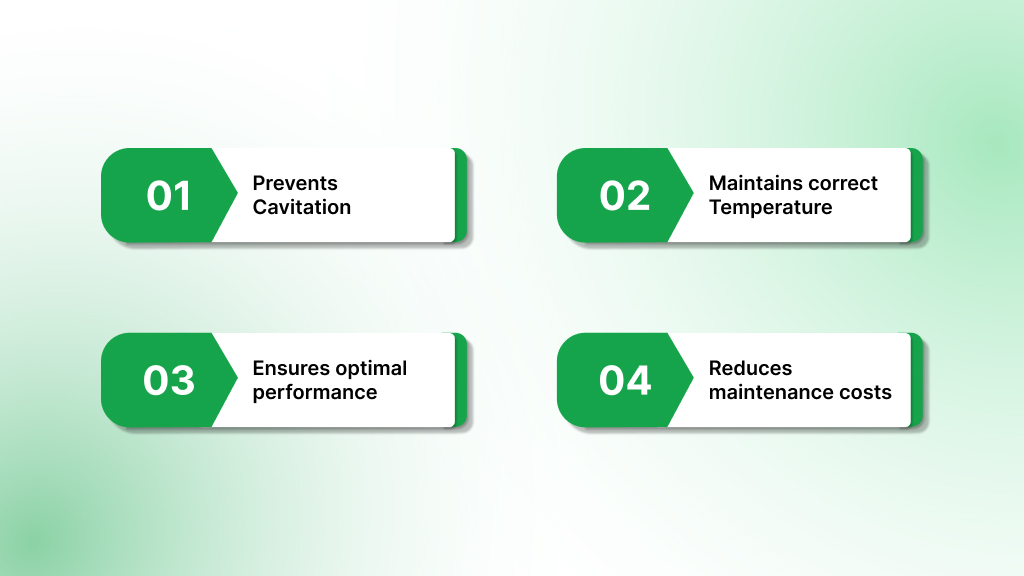
- Prevents cavitation: Cavitation forms bubbles that implode inside the pump, damaging impellers and other internal parts preventing risk.
- Maintains correct operating temperature: Pumps running dry overheat quickly, which can damage seals, bearings, and motors ensuring proper lubrication and cooling.
- Ensures optimal performance: A primed pump reaches its designed flow and pressure levels immediately, improving system reliability.
- Reduces maintenance costs: Preventing air-related damage minimizes repairs, part replacements, and unplanned downtime.
With the importance and benefits of priming pumps clear, it is equally important to know the situations that require this process.
When Do You Need to Prime Your Pump?
Priming is necessary in several common situations to maintain effective pump operation:
- Initial startup: Every pump either metallic or non-metallic must be primed when first installed to establish the proper fluid column.
- After maintenance or repairs: Any service that opens the suction line or disassembles pump components requires re-priming.
- After losing prime: Air leaks, system shutdowns, or extended inactivity can allow the pump to lose prime, making it necessary to repeat the process.
- When suction lines are drained: If the fluid in the suction line has been emptied for cleaning, maintenance, or seasonal shutdowns, priming restores proper operation.
- Following system modifications: Changes in piping, valves, or tank levels can introduce air, requiring a fresh priming cycle.
With this foundation, you can now explore the essential steps for priming your pump effectively.
How to Prime Your Pump: 6 Steps for Reliable Use
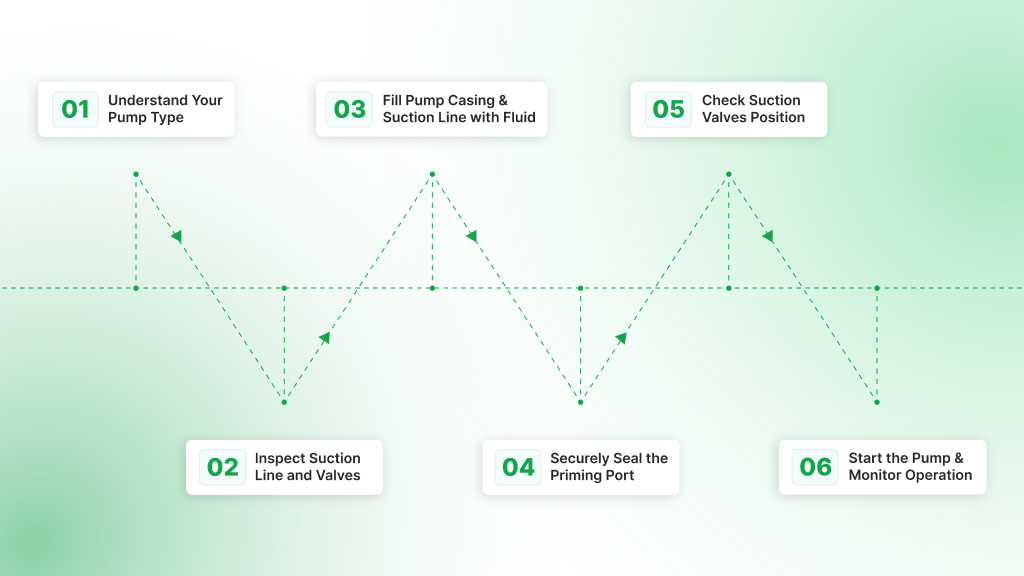
Priming your pump is the essential first step before putting it into operation. It ensures the pump’s internal cavity is filled with liquid, eliminating air pockets that can cause cavitation, overheating, and damage.
When priming is overlooked or done incorrectly, the entire pumping system suffers from reduced efficiency to costly downtime.
Here’s a complete checklist outlining what to do and how to prime your pump the right way.
1. Understand Your Pump Type and Priming Requirements
Priming methods vary depending on the pump design. Centrifugal pumps are typically not self-priming and require filling with fluid before startup, while positive displacement pumps often have self-priming capabilities.
Why this matters:
Using an incorrect priming method or skipping priming can lead to dry running, causing damage to seals, impellers, and other internal components. Following manufacturer guidelines and knowing your pump’s specific requirements prevents guesswork and reduces the risk of costly repairs.
What to do:
- Turn off electrical power to the pump and system.
- Locate a convenient plumbing fixture or priming port.
- Check piping, drain plugs, fasteners, and valves for damage or looseness.
- Confirm valves operate smoothly.
Result: Selecting the right priming technique protects your pump from avoidable failures and ensures smooth, efficient fluid flow from the start.
2. Inspect the Suction Line and Valves Before Priming
Before beginning the priming process, it is essential to ensure that the suction line is clean, intact, and free of any blockages or air pockets. Proper inspection at this stage prevents delays during priming and protects the pump from damage.
What to check:
- Confirm that all valves on the suction side are fully open to allow uninterrupted fluid flow.
- Examine suction pipe joints, fittings, and connections for leaks that could let air enter the system.
- Remove any debris, sediment, or buildup that could obstruct fluid movement or reduce pump efficiency.
- Check that suction strainers or filters are clean and properly installed.
Result: A clear and airtight suction line allows fluid to reach the pump quickly, facilitates faster priming, and reduces the likelihood of losing prime during operation. It also helps prevent cavitation, dry running, and unnecessary wear on pump components.
3. Fill the Pump Casing and Suction Line with Fluid

The pump and suction line must be completely filled with the fluid that the pump will circulate. This step removes air and establishes the suction necessary for proper operation.
How to do it:
- Open the priming port or plug on the pump casing.
- Slowly pour water or the intended process fluid into the casing until it reaches the top or begins to overflow.
- In some systems, an external priming pump can be used to inject fluid directly into the suction line and pump casing, ensuring complete filling.
- Check that all valves along the suction line are in the correct positions to allow fluid flow into the pump.
Why this matters: Air trapped inside the pump or suction line prevents pressure from building up. This reduces suction efficiency, can cause cavitation, and may result in dry running, which damages seals, bearings, and impellers.
Result: Filling the pump casing and suction line removes all air pockets, ensures smooth fluid flow, and enables the pump to start reliably and operate at optimal performance.
4. Securely Seal the Priming Port
After filling the pump and suction line with fluid, it is essential to close and tighten the priming plug or port to ensure no air can enter the system. Proper sealing is a simple step that protects the pump from future operational issues.
Why this matters:
- If the priming port is not sealed correctly, air can leak back into the pump, causing a loss of prime. This not only interrupts fluid flow but can also lead to cavitation, overheating, and potential damage to the impeller and seals.
- Ensuring all connections and fittings are tight eliminates these risks and promotes stable operation.
Result: An airtight priming port preserves the prime, maintains smooth fluid flow, prevents cavitation, and reduces the likelihood of repeated priming, safeguarding the pump and extending its lifespan.
5. Check Discharge and Suction Valves Position
Prior to operating the pump, it is important to verify the positions of valves on both the suction and discharge sides. Proper valve positioning ensures correct flow, reduces mechanical stress, and supports successful priming.
Why this matters: Incorrect valve positions can increase pump load, reduce flow, and prevent the pump from priming. Overloading or throttling the pump improperly can lead to mechanical wear, seal damage, or overheating.
Result: Verifying valve positions ensures the pump operates under correct flow conditions, facilitates proper priming, and minimizes the risk of damage or operational delays.
6. Start the Pump and Monitor Operation
With the pump fully primed and all valves correctly positioned, it is time to start the pump and observe its performance carefully.
What to observe:
- Ensure smooth and consistent fluid flow throughout the system.
- Check pressure readings for stability and alignment with expected operating levels.
- Listen for unusual noises such as rattling, knocking, or cavitation sounds that indicate potential issues.
- Monitor vibration levels and motor temperature to detect early signs of distress or imbalance.
- Observe any leakage around seals, gaskets, or connections that could affect performance.
Why this matters: Early detection of anomalies allows you to address problems before they escalate into major failures. Identifying issues during startup protects internal components, prevents downtime, and reduces maintenance costs.
Result: Stable flow, correct pressure, and normal vibration and temperature readings confirm that the pump has been successfully primed and is ready for reliable operation. Prompt corrective action in case of abnormalities ensures long-term pump efficiency and safety.
With the priming process complete, it is crucial to review best practices and anticipate challenges for optimal pump performance.
Pump Priming: Best Approaches and Operational Challenges
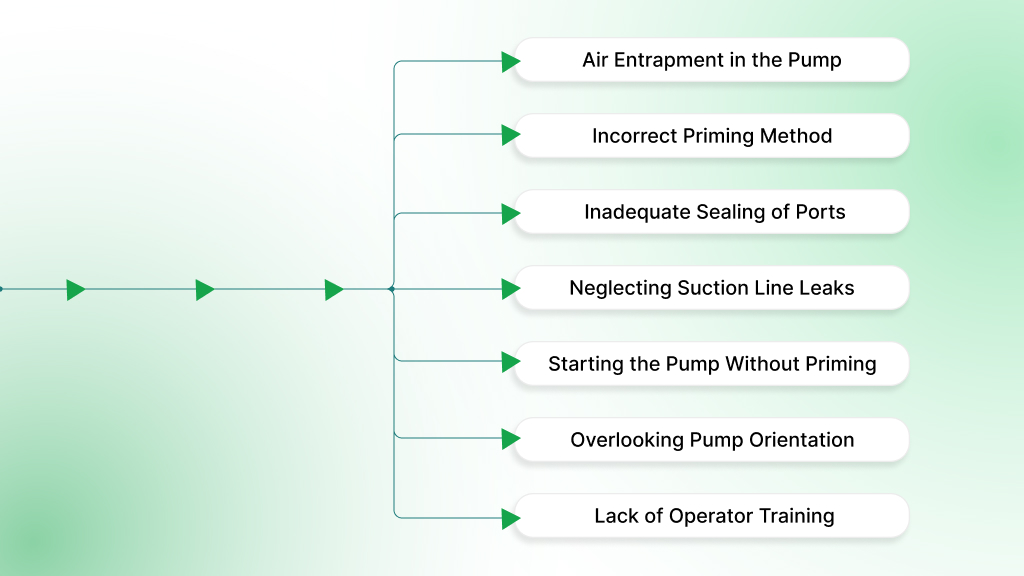
Neglecting priming steps or applying incorrect techniques can lead to airlocks, cavitation, and early pump failure. Even experienced plant engineers and technicians face challenges that may impact pump efficiency and lifespan.
Below is a breakdown of key challenges in pump priming, along with best practices to help you avoid costly downtime and maintain smooth pump operation.
1. Air Entrapment in the Pump and Suction Line
Air pockets trapped inside the pump casing or suction line can cause loss of prime, cavitation, and vibration issues.
Best Practice: Fully fill the pump casing and suction line with fluid during priming. Use vent valves or priming ports to purge trapped air completely before starting the pump.
2. Incorrect Priming Method for Pump Type
Different pump designs (centrifugal, diaphragm, self-priming) require tailored priming techniques. Applying a generic priming approach can reduce efficiency or damage components.
Best Practice: Follow OEM guidelines specific to your pump model. For centrifugal pumps, manual filling is common, while self-priming pumps rely on built-in mechanisms — verify priming procedures before operation.
3. Inadequate Sealing of Priming Ports
Loose or improperly sealed priming plugs can allow air ingress during pump operation, leading to loss of prime and performance drop.
Best Practice: Ensure all priming plugs and valves are tightly sealed after priming. Use thread sealants or gaskets as recommended to prevent air leaks.
4. Neglecting Suction Line Leaks
Leaks on the suction side can cause air to enter the system, making priming difficult or impossible and reducing pump suction capability.
Best Practice: Perform regular inspection and maintenance of suction piping and fittings. Repair or replace any damaged sections immediately to maintain system integrity.
5. Starting the Pump Without Priming
Running a pump dry without priming causes overheating, mechanical seal failure, and rapid wear of bearings and impellers.
Best Practice: Always confirm the pump is fully primed before startup. Use visual checks or instrumentation if available, and never run the pump empty.
6. Overlooking Pump Orientation and Installation
Improper pump placement and suction line layout can trap air and complicate priming efforts.
Best Practice: Design the suction line with minimal high points and use proper slope to avoid air pockets. Install the pump as per OEM recommendations to facilitate efficient priming.
7. Lack of Operator Training on Priming Procedures
Operators unfamiliar with correct priming techniques may skip critical steps or perform them incorrectly, risking equipment damage.
Best Practice: Provide thorough training on pump priming procedures, including hands-on demonstrations and reference to OEM manuals and safety standards.
Facing challenges in pump priming? Chemitek offers advanced solutions and expert guidance to simplify priming processes and improve pump reliability. Explore how we can support your operations.
How Chemitek Centrifugal Pumps Maintain Reliable Operation?
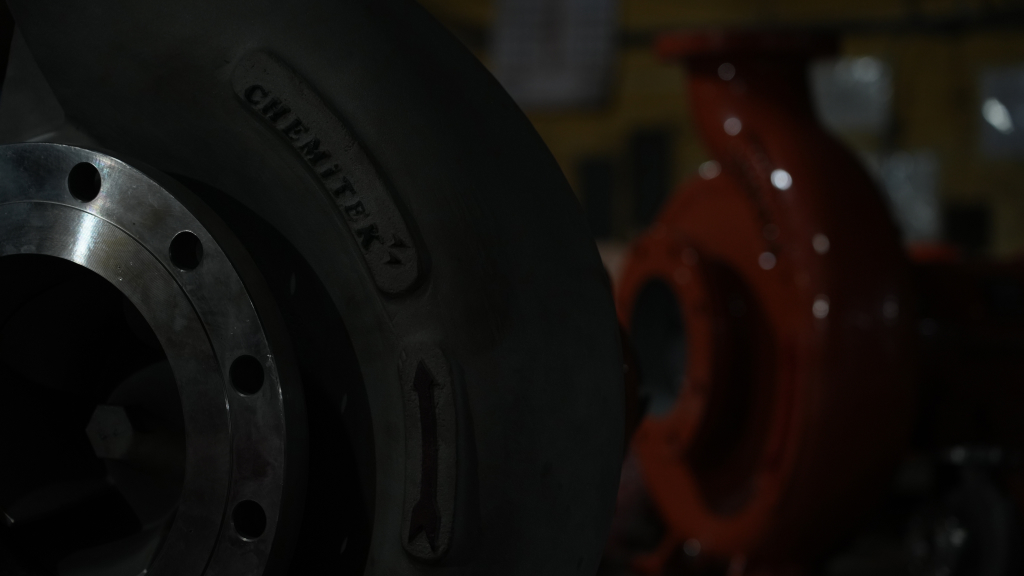
At Chemitek Process Equipment Pvt. Ltd., we focus on practical, field-proven priming techniques for every pump type and application. Since 2009, we have supported industrial operations with pumps made from SS316, Alloy 20, Hastelloy, and other premium materials.
All pumps meet ANSI/ASME B73.1 standards and real-world testing. From centrifugal to slurry and chemical pumps, correct priming prevents air locks, avoids dry running, and protects critical components. Our step-by-step approach ensures proper fluid filling, air removal, and sealing for continuous or batch operations.”
With Chemitek, priming isn’t just a one-time task, it’s part of a comprehensive maintenance plan designed to keep your pumps running efficiently and your operations stable.
Contact us today to ensure your pumps start strong and perform reliably through every cycle.
FAQs
1. Why is priming a pump necessary?
Priming removes trapped air inside the pump and suction line to allow fluid flow. Without priming, the pump can run dry, lose suction, or suffer damage from overheating and cavitation. It ensures the pump starts smoothly and operates efficiently.
2. How do I know if my pump needs priming?
If the pump fails to draw fluid, makes unusual noises, or loses suction after being idle, it likely lost its prime. Pumps also need priming when started for the first time or after maintenance that empties the suction line.
3. Can I run a pump without priming it?
Running a pump dry without priming can cause serious damage, including overheating, seal failure, and reduced pump life. Always prime the pump properly before starting it to avoid costly repairs.
4. How often should I prime my pump?
Priming frequency depends on the pump type and system setup. Generally, prime before every startup if the pump or suction line empties between uses. Pumps with self-priming capabilities may need less frequent manual priming.
5. What are common issues that prevent successful pump priming?
Air leaks in suction lines, blocked valves, or worn seals can prevent proper priming. Ensure all connections are tight, suction lines are clear, and seals are in good condition to maintain prime.
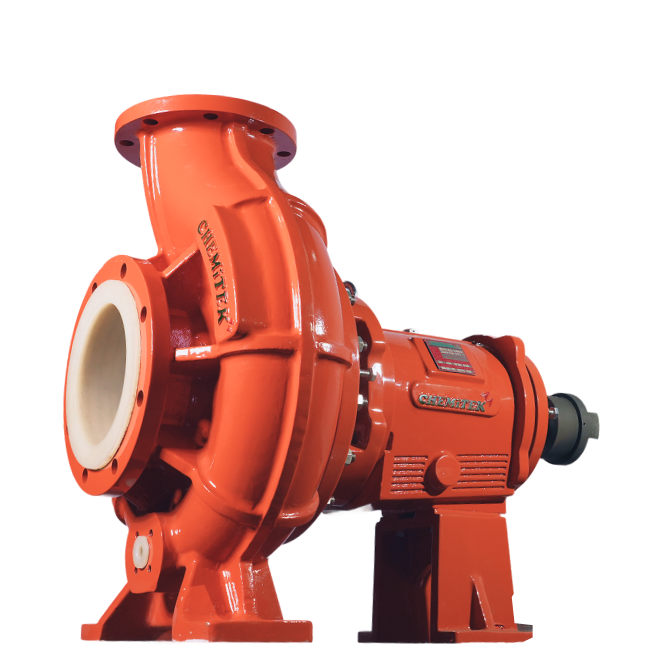
Latest posts

Priming Pump: Steps to Ensure Smooth and Efficient Operation
Ready to Upgrade Your Process Operations?